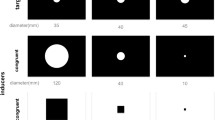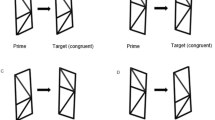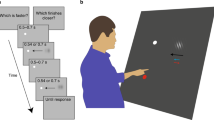Abstract
A number of studies have shown that while perceptual judgment is deceived by pictorial illusions, grasping and other kinds of motor behaviour are not. This is in keeping with the existence of two different cortical systems: a ventral stream subserving vision-for-perception and a dorsal stream subserving vision-for-action. The former is sensitive to illusions, the latter is not. Given this dissociation of functions, one wonders whether simple visuomotor reaction time (RT) follows the ventral or the dorsal rule in perceiving illusory figures. Answering this question might contribute to a better understanding of the different functions of the two systems. We carried out two experiments, one with the Ponzo and the other with the Ebbinghaus–Titchener illusion and found that RT is sensitive to both illusions with faster responses to stimuli appearing illusorily bigger than the others. These results show that motor action is subserved by the ventral system when that action directly reports the presence or onset of a target rather than when that action requires a spatial adjustment that reflects the physical features of the target.


Similar content being viewed by others
References
Aglioti S, DeSouza J, Goodale MA (1995) Size-contrast illusions deceive the eyes but not the hand. Curr Biol 5:679–685
Amazeen EL, DeSilva F (2005) Psychophysical test for the independence of perception and action. J Exp Psychol Hum Percept Perform 31:170–182
Brenner E, Smeets JB (1996) Size illusion influences how we lift but not how grasp an object. Exp Brain Res 111:473–476
Bruno N, Franz VH (2009) When is grasping affected by the Müller–Lyer illusion? A quantitative review. Neuropsychologia 47:1421–1433
Bruno N, Bernardis P, Gentilucci M (2008) Visually guided pointing, the Müller–Lyer illusion, and the functional interpretation of the dorsal–ventral split: conclusion from 33 independent studies. Neurosci Biobehav Rev 32:423–437
Carlson VR (1962) Size constancy judgments and perceptual compromise. J Exp Psychol 63:68–73
Dewar MT, Carey DP (2006) ‘Visuomotor immunity’ to perceptual illusion: a mismatch of attentional demands cannot explain the perception–action dissociation. Neuropsychologia 44:1501–1508
Donkelaar PV (1999) Pointing movements are affected by size-contrast illusions. Exp Brain Res 125:517–520
Dyde RT, Milner AD (2002) Two illusions of perceived orientation: one fools all of the people some of the time; the other fools all of the people all of the time. Exp Brain Res 144:518–527
Fang F, Boyaci H, Kersten D, Murray SO (2008) Attention-dependent representation of a size illusion in human V1. Curr Biol 18:1707–1712
Fischer MH (2001) How sensitive is hand transport to illusory context effects? Exp Brain Res 136:224–230
Franz VH, Gegenfurtner KR, Bülthoff HH, Fahle M (2000) Grasping visual illusions: no evidence for a dissociation between perception and action. Psychol Sci 11:20–25
Franz VH, Bülthoff HH, Fahle M (2003) Grasp effects of the Ebbinghaus illusion: obstacle avoidance is not the explanation. Exp Brain Res 149:470–477
Goodale MA, Gonzalez CL, Króliczak G (2008) Action rules: why the visual control of reaching and grasping is not always influenced by perceptual illusions. Perception 37:55–66
Gregory RL (2005) The Medawar lecture 2001 knowledge for vision: vision for knowledge. Philos Trans R Soc Lond B Biol Sci 360(1458):1231–1251
Haffenden AM, Goodale MA (1998) The effect of pictorial illusion on prehension and perception. J Cogn Neurosci 10:122–136
Jackson SR, Shaw A (2000) The Ponzo illusion affects grip-force but not grip-aperture scaling during prehension movements. J Exp Psychol Hum Percept Perform 26:418–423
Kwok RM, Braddick OJ (2003) When does Titchener circles illusion exert an effect on grasping? Two- and three-dimensional targets. Neuropsychologia 41:932–940
Leibowitz H, Brislin R, Perlmutter L, Hennessy R (1969) Ponzo perspective illusion as a manifestation of space perception. Science 166:1174–1176
Marzi CA, Mancini F, Metitieri T, Savazzi S (2006) Retinal eccentricy effects on reaction time to imagined stimuli. Neuropsychologia 44:1489–1495
Milner AD, Goodale MA (2008) Two visual systems re-viewed. Neuropsychologia 46:786–802
Murray SO, Boyaci H, Kersten D (2006) The representation of perceived angular size in human primary visual cortex. Nat Neurosci 9:429–434
Osaka N (1976) Reaction time as a function of peripheral retinal locus around fovea: effect of stimulus size. Percept Motor Skill 42:603–606
Otto-de Haart EG, Carey DP, Milne AB (1999) More thoughts on perceiving and grasping the Müller–Lyer illusion. Neuropsychologia 37:1437–1444
Pavani F, Boscagli L, Benvenuti F, Rabuffetti M, Farnè A (1999) Are perception and action affected differently by the Titchener circles illusion? Exp Brain Res 127:95–101
Payne WH (1967) Visual reaction time on a circle about the fovea. Science 155:481–482
Previc FH (1990) Functional specialization in the lower and upper visual fields in humans: its ecological origins and neurophysiological implications. Behav Brain Sci 13:519–575
Servos P, Carnahan H, Fedwick J (2000) The visuomotor system resists the horizontal–vertical illusion. J Mot Behav 32:400–404
Smeets J, Brenner E (2006) 10 years of illusions. J Exp Psychol Hum Percept Perform 32:1501–1504
Sperandio I, Savazzi S, Gregory RL, Marzi CA (2009) Visual reaction time and size constancy. Perception (in press)
Ungerleider L, Mishkin M (1982) Two cortical visual systems. In: Ingle DJ, Goodale MA, Mansfield RJW (eds) Analysis of visual behaviour. MIT Press, Cambridge, pp 549–586
Vishton PM, Rea JG, Cutting JE, Nuñez LN (1999) Comparing effects of the horizontal–vertical illusion on grip scaling and judgment: relative versus absolute, not perception versus action. J Exp Psychol Hum Percept Perform 25:1659–1672
Wolfe U, Maloney LT, Tam M (2005) Distortions of perceived length in the frontoparallel plane: tests of perspective theories. Percept Psychophys 67:967–979
Author information
Authors and Affiliations
Corresponding author
Rights and permissions
About this article
Cite this article
Sperandio, I., Savazzi, S. & Marzi, C.A. Is simple reaction time affected by visual illusions?. Exp Brain Res 201, 345–350 (2010). https://doi.org/10.1007/s00221-009-2023-y
Received:
Accepted:
Published:
Issue Date:
DOI: https://doi.org/10.1007/s00221-009-2023-y




